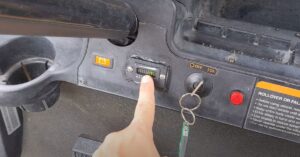Can I Charge My Golf Cart With Jumper Cables?
Ever found yourself stranded with a dead golf cart battery, jumper cables in hand, and wondering what to do next? Imagine the ease if you could simply connect those cables and bring your golf cart back to life!
Yes, indeed! You can charge your golf cart using jumper cables. However, this process requires careful attention as it’s not as straightforward as charging an ordinary car battery.
Curious about how it works? Stick around for some handy tips that will save you from potential mishaps while ensuring a successful recharge every time. Let’s dive into the nitty-gritty of safely charging your golf cart using jumper cables without causing any damage.
Key Takeaways
- Jumper cables can be used to charge a golf cart, but caution is crucial.
- Ensure the voltage and amperage are compatible before attempting a jump start.
- Follow proper safety procedures and consult your golf cart’s manual for guidance.
- Regularly maintain your golf cart’s battery to avoid relying on jumper cables.
Can you charge your golf cart with jumper cables?
Yes, it is possible to charge your golf cart using jumper cables. Jumper cables are typically used to jump-start vehicles with dead batteries by connecting them to a running vehicle’s battery. Similarly, you can use jumper cables to transfer power from another vehicle or external power source to your golf cart’s battery.
However, before attempting this method, it is important to consider a few factors. First and foremost, ensure that the voltage of the power source matches the voltage required by your golf cart’s battery. Most golf carts operate on 36 or 48 volts, so make sure the power source aligns with these specifications.
Additionally, take note of the polarity when connecting the jumper cables. The positive cable (usually red) should be connected to the positive terminal of both batteries while the negative cable (usually black) should be connected to the negative terminals.
To avoid any potential damage or accidents, follow these steps carefully:
- Ensure both vehicles are turned off.
- Connect one end of each jumper cable to their respective positive and negative terminals on both batteries.
- Start the donor vehicle and let it run for a few minutes.
- If necessary, start your golf cart and allow it some time for charging.
Keep in mind that using jumper cables as a long-term solution is not recommended as they are designed for temporary situations only. If you regularly find yourself needing an alternative charging method for your golf cart, consider investing in a dedicated charger specifically designed for electric vehicles like golf carts.
What are the risks of charging a golf cart with jumper cables?
Charging a golf cart using jumper cables may seem like a quick fix, but it comes with its fair share of risks. Let’s dig deeper into why this method can be dangerous and what you need to know.
Electrical Damage
Jumper cables are designed for vehicles with 12-volt systems, while most golf carts operate on 36 or 48 volts. Connecting the higher voltage batteries in your golf cart to a lower voltage vehicle can cause electrical damage to both the cart and the vehicle.
Battery Explosion
If you mistakenly connect the positive terminal of one battery to the negative terminal of another, it can lead to an explosion or fire hazard. This is especially true when dealing with high-voltage batteries found in golf carts.
Inadequate Charging
Jumper cables are not designed for long-term charging; they are meant for jump-starting dead batteries temporarily. Using them as a regular charging method can result in incomplete charging cycles and reduce battery life over time.
Safety Hazards
Handling jumper cables without proper knowledge and precautions increases the risk of electric shock or short circuits, which could harm you or damage your equipment.
To ensure safe and effective charging for your golf cart, it is recommended to use a dedicated charger specifically designed for these types of batteries. These chargers provide optimal voltage levels and charging algorithms that prolong battery life while minimizing risks associated with improper charging methods.
specific instructions for safely charging a golf cart with jumper cables
If you find yourself in need of charging your golf cart and don’t have access to a charger, using jumper cables can be a viable option. However, it is important to follow specific instructions to ensure the process is done safely and effectively.
Firstly, make sure that both the donor vehicle (the one providing power) and the golf cart are turned off before attempting any connections. This will prevent any potential electrical mishaps during the process.
Next, locate the positive (+) and negative (-) terminals on both vehicles. These terminals are usually marked with corresponding symbols or colors. It’s crucial to match these correctly to avoid damaging either vehicle’s electrical system.
Once you’ve identified the terminals, connect one end of the positive jumper cable clamp to the positive terminal of the donor vehicle’s battery. Then, attach the other end of this same cable clamp to the positive terminal on your golf cart’s battery.
Moving on to the negative terminal connections, attach one end of the negative jumper cable clamp to the negative terminal of your donor vehicle’s battery. However, instead of connecting it directly to your golf cart’s battery as you did with the positive terminal, find an unpainted metal surface on your golf cart’s frame or engine block nearby and secure it there securely.
With all connections in place, start up your donor vehicle and let it run for a few minutes while maintaining a steady idle speed. This allows some charge from its battery to transfer into your golf cart’s battery gradually.
Remember not to rev up or accelerate excessively during this time as it may cause damage due to sudden voltage surges. After several minutes have passed by allowing sufficient charging time between batteries’, try starting up your golf cart.
If successful, disconnecting everything should be done in reverse order: remove negative clamps first followed by positive ones ensuring no contact between them or any metallic surfaces to prevent sparks. It is also important to note that if your golf cart fails to start after this process, it may indicate a more significant issue with the battery or electrical system requiring professional assistance.
How long does it take to charge a golf cart using jumper cables?
To give you an idea, let’s assume you have a standard 48-volt lead-acid battery in your golf cart. If the battery is completely discharged, it may take anywhere from 8 to 12 hours to fully charge using jumper cables. This estimate can vary depending on the charger’s amperage output and the condition of the battery.
It’s important to note that charging a golf cart with jumper cables is not meant for regular or long-term use. Jumper cables are typically used as a temporary solution when your regular charger is unavailable or if you need to jump-start your cart quickly.
When connecting jumper cables, make sure you follow proper safety procedures. Always connect positive-to-positive (+) terminals first and negative-to-negative (-) terminals second. Once connected, allow enough time for the charger to replenish energy into the discharged battery before attempting to start your golf cart.
Is it recommended to charge a golf cart regularly with jumper cables, or are there better alternatives?
Is it recommended to charge a golf cart regularly with jumper cables, or are there better alternatives? Let’s find out. When it comes to charging your golf cart, using jumper cables may seem like a convenient option. However, there are some drawbacks to consider.
Firstly, jumper cables are designed for short-term use and not meant for regular charging. Using them consistently can lead to overheating and damage to the battery or electrical system of your golf cart.
Secondly, jumper cables do not provide a controlled and regulated charge like a proper charger does. This means that you may end up overcharging or undercharging your battery, which can shorten its lifespan.
So what are the better alternatives? Investing in a dedicated golf cart charger is highly recommended. These chargers are specifically designed for golf carts and provide optimal charging conditions for the batteries.
A good quality charger will have features such as automatic shut-off when the battery is fully charged, preventing overcharging. It will also offer various charging modes to cater to different types of batteries.
In addition to using a dedicated charger, it is important to follow proper charging practices. Regularly check the water levels in your batteries and keep them properly topped up if necessary. Avoid leaving your golf cart plugged in for extended periods without use as this can also be harmful.
By using a dedicated charger and following best practices, you can ensure that your golf cart’s battery remains healthy and provides long-lasting performance on the green.
FAQs
Q: Is it safe to charge my golf cart with jumper cables?
A: It is not recommended to charge a golf cart with jumper cables as it can cause damage to the electrical system and potentially be dangerous. It is best to use a proper charger designed for golf carts.
Q: Can I use jumper cables in an emergency if my golf cart battery dies?
A: In an emergency situation, you can use jumper cables to jump-start your golf cart from another vehicle. However, this should only be done temporarily as a solution to get the cart running and should not be used as a regular charging method.
Q: What are the risks of charging a golf cart with jumper cables?
A: Charging a golf cart with jumper cables can lead to overcharging, which can damage the batteries and shorten their lifespan. Additionally, improper connections or incorrect voltage can cause electrical issues or even pose safety hazards.
Q: What is the correct way to charge a golf cart battery?
A: The recommended way to charge a golf cart battery is by using a dedicated charger specifically designed for that purpose. These chargers provide the right voltage and amperage required for efficient and safe charging of the batteries.



![How To Charge A Golf Cart With Dead Batteries? [A Comprehensive Guide] how-to-charge-a-golf-cart-with-dead-batteries](https://giftedgolfers.com/wp-content/uploads/2023/06/how-to-charge-a-golf-cart-with-dead-batteries-300x157.jpg)
